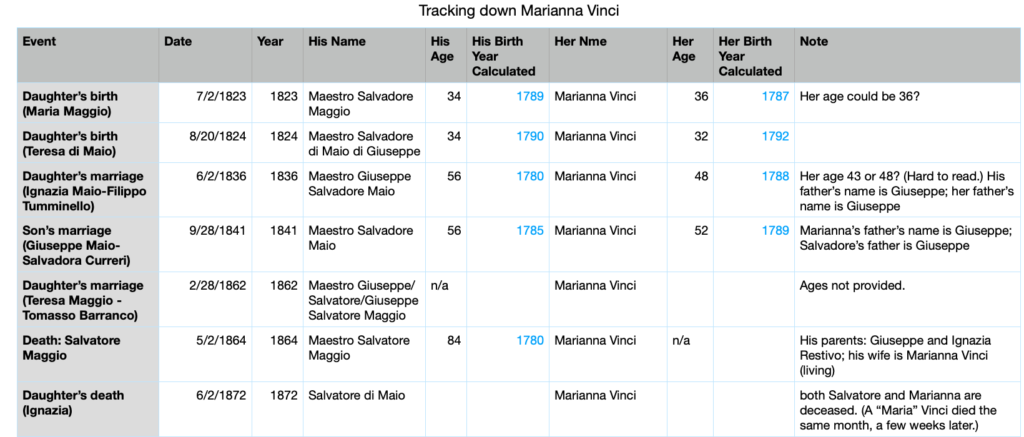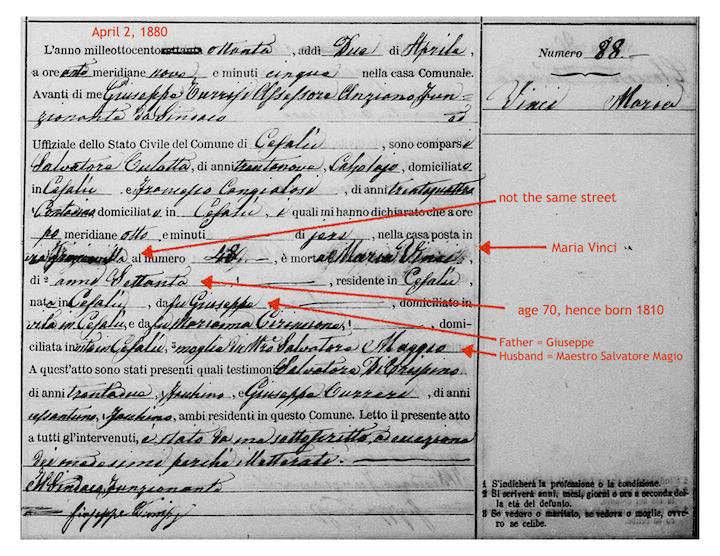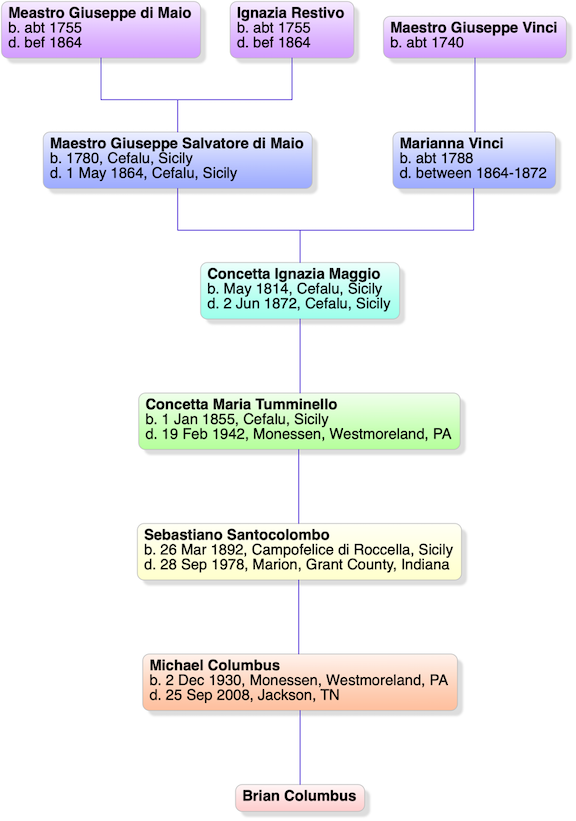As I mentioned previously, sometimes I pick a person at the end of a line and focus on researching their life, hoping to find clues about them or beyond them. For several weeks now I’ve been looking for more hints about Marianna Vinci, my 3x-great-grandmother from Cefalu, Sicily, specifically when she died, and unlike other excursions this one seems to find more questions than answers.
I have her name from several sources, including marriage, birth, and death records, and she’s alway listed as Marianna Vinci. Her age, however, has vacillated from document to document, but within about a 5-year span. Although, this is not unusual with such records.
To give you a sense of the mind-numbing, tedious things I’ve done, that I strangely enjoy doing, here are some of what I’ve done over the past few weeks, using online, digitized microfilm at places like Antenati Archives and FamilySearch.org:
– scoured death records from 1862 to 1890, checking every index (alphabetical listing at the end of each year) and going page-by-page through the 1867 records because the index is not available. I didn’t find her death, although I did find a couple of records for a Maria Vinci.
– searched for other children’s birth records, to confirm ages (and found another child, Maria)
– searched for children’s marriage records, to confirm ages (and found a son’s marriage, Giuseppe, and a daughter’s, Teresa)
And while I found some records of relatives from a few lines as well as Marianna’s, none of that truly resolved anything.
Her husband, my 3x-great-grandfather, was also in many of these records and his age also shifted, although slightly less, but his name varied more than hers throughout. He had the surname of di Maio, or in some records, Maggio.
It’s important to know that the spelling of names is not an exact science, especially before the 1900s, so it’s not uncommon to find various spellings. In many instances they were written phonetically, and after all, most people were illiterate, so spelling was left to those who could. Maio and Maggio are very similar, even in the pronunciation (MY-yo, and MY-jo). Of course, I can’t say what that sound was really like in the 19th century Sicilian dialect, and may have been closer in sound, which might explain the variety in spelling. Nonetheless, I’ve seen records that are indisputably for the same person, at different times, and use the different versions.
Great-great-great grandpa di Maio’s first name was Salvatore, or in some records Salvatore Giuseppe. Actually, in the various documents that accompany his daughter’s marriage record (my 2x-great-grandparents) he’s actually listed as Giuseppe in one place and Salvatore in another and Giuseppe Salvatore in yet another! In almost every instance, in these and other records, he’s given the title of Maestro and listed with the same occupation, bottaio – a cooper. The use of the term “Maestro” is an indication of a higher status in the community and his profession. A cooper is someone who makes things like barrels and casks from wood, something that was likely a very important trade.
I should point out that just having scrolled through so many records, I also know there are others named Salvatore di Maio and Salvatore Maggio, not surprisingly due to the naming conventions. (My uncles have several cousins with the same names as theirs.) So part of me wondered about the chances of two couples with the same names, of about the same ages. Statistically, it’s not impossible. That cooper occupation, and an address on Strada Veterani has been helpful in making other connections, from document to document and year to year. It seems the family lived on Veterani for over 40 years.
Breakthrough! While reviewing all these documents, a few of which I’ve had for years (and I mean literally reviewing them as I’m drafting this post) I realized I hadn’t caught a coupe bits of one long, hand-written page in my 2x-great-grandparents marriage records that identified the fathers of the newlywed’s mothers, including confirming Marianna Vinci’s father was Giuseppe (also titled “maestro”) and from the other side of the marriage, my other 4x-great-grandfather, Rosario Petarra. So some of what I’ve been looking for all along was sitting right here in my files!
Still, I’m a bit stumped as to why I can’t find when Marianna died. And yes, I’m presuming she has. According to the records, she was living when her husband (Maestro Salvatore Maggio) died in 1864, but was deceased by the time her daughter (Ignazia) died in 1872.
When I put it all together, the pieces don’t quite all fall into place. I actually had resort to putting it all in a spreadsheet!

Ultimately I’m looking for a death record between 1864 and 1872. I found a death record for Marianna Vinci in the 1870s, but that Marianna was only 10 years old. I also found two Maria Vincis – one of them the right age but wrong husband, the other the right husband’s and father’s names, but her age is off by about around 20 years, and her husband, Maestro Salvatore Maggio, was still living when he shouldn’t be. This latter one is my closest possibiity, but with the discrepancies I’m still uncertain.

After all, she couldn’t have been born in 1810 if her first child was born in 1814. What are the chances the record has errors, such as missing the “fu” (“was”) regarding Salvatore and using “moglie” (“wife”) instead of “vedova” (“widow”) and getting her age of around ninety (“novanta”) wrong and putting “settanta” (“seventy”) instead? It’s all a bit too much.
If I could get my hands on a marriage record for Salvatore/Giuseppe and Marianna, likely around 1810 or 1812, I might really learn more about her parents.
This review of the minutia of details, and confirmation of information to establish facts, is the criteria I try to use in determining all these kinds of connections. It’s the hunt, the detective work, that I really enjoy in my genealogical research.
How did I get here? Marianna and Salvatore’s great-grandchildren would all start to immigrate to the US around the turn of the century, long after they were deceased, and this included my grandfather Sebastiano Santocolombo.

It’s interesting you mentioned Via Veterani. In 2019 during our trip to Cefalù, we had a great dinner at a restaurant on that street named Le Botte. Botte means casks, interestingly enough. I wonder if that street is where the coopers/bottaio lived and worked. It’s something to think about and perhaps it might provide some additional information. As usual, your research is amazing and fascinating.
It’s where they lived, and I would love to discover where he worked! His son, Giuseppe, had the same profession. I’m jealous you’ve walked down that street. Someday, I will too.